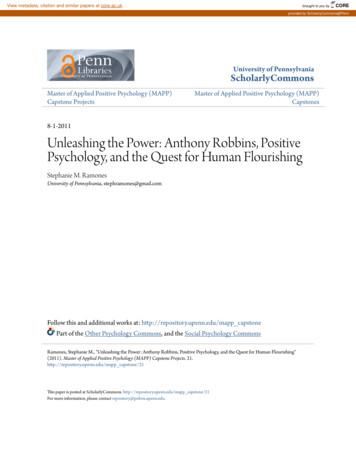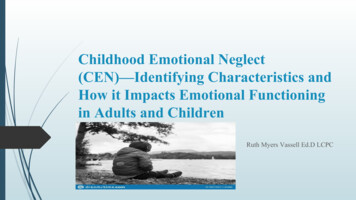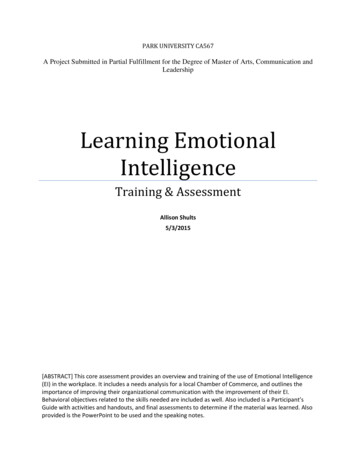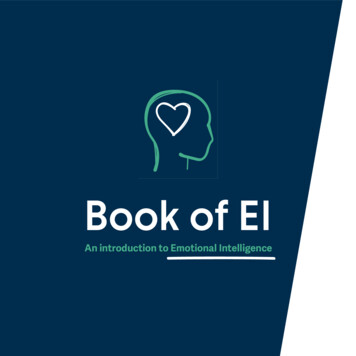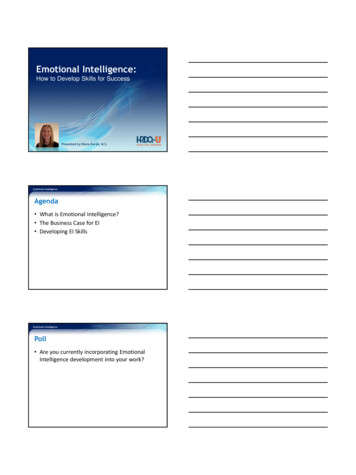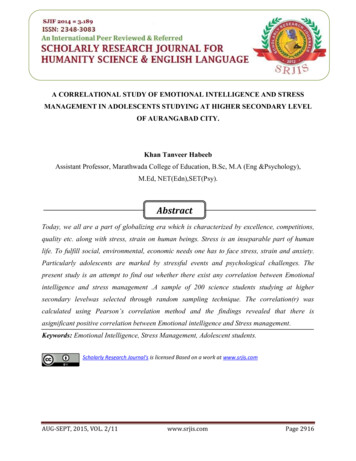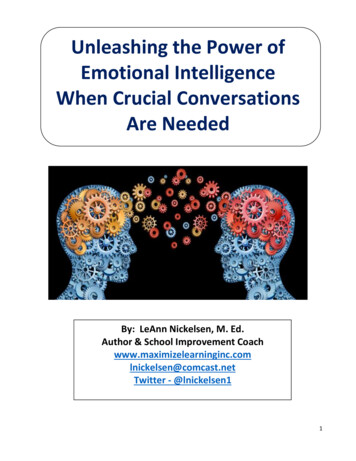
Transcription
Unleashing the Power ofEmotional IntelligenceWhen Crucial ConversationsAre NeededBy: LeAnn Nickelsen, M. Ed.Author & School Improvement .netTwitter - @lnickelsen11
Biography Page: LeAnn Nickelsen, M.Ed.LeAnn M. Nickelsen, educator for over 20 years, is delivering several presentations nationally on brainresearch topics, differentiation, reading and vocabulary strategies, nutrition affecting cognition, all based onthe latest research. She is known for delivering a wealth of information in an active, fun format with veryspecific, practical classroom examples. Participants walk out with many ideas and a passion for maximizinglearning for all students!In addition to her trainings, LeAnn also models lessons within the classroom. She works with teachers oneon-one and in small groups to help them achieve their educational goals. She is a parent of school-age twinsand applies the research to the hardest jobs out there, parenting and teaching.Qualifications Certified Brain Research Trainer (Jensen Learning)Masters in Educational Administration, University of North TexasSeveral years teaching in the classroom in Kansas, Texas, & OhioMember of: National Staff Development Council; Association of Supervision and Curriculum DevelopmentTeacher of the Year in Grapevine-Colleyville, TXCo-Author with Eric Jensen – 1.) Bringing the Common Core to Life in K-8: 30 Strategies to Build Literacy Skills(Solution Tree, 2014) 2.) Deeper Learning: 7 Powerful Strategies for In-Depth and Longer-Lasting Learning(Corwin Press, 2008)Co-Author with Linda Allen - Making Words Their Own (Crystal Springs, 2008)Co-Author of Differentiating by Readiness (Eye on Education, 2010)Author of the following teacher resource books published by Scholastic, Inc.:*Quick Activities to Build a Very Voluminous Vocabulary (1998)*Teaching Elaboration & Word Choice (2001)*Comprehension-Building Activities for Reading in Social Studies & Science (2003)*Four book Mini-Comprehension Reading series: Inferences & Cause/Effect; Sequencing & Context Clues; Pointof View & Fact/Opinion, Main Idea & Summarizing (2004)*Memorizing Strategies & Other Brain-Based Activities (2004)Presentation Topics1. Differentiation: Building Success for All, Grades K-122. Engage with the Common Core State Standards, K-123. Diving Into Deeper Learning, Grades 4-124. Teaching With Poverty in Mind, Grades K-125. SavvyVocab: Making Words Their Own, Grades K-126. Differentiating Classrooms: The Tiered Approach, Grades K-127. Assessment Over- Easy Please, Grades K-128. Super Highway: Understanding the Adolescent Brain, Grades 6-129. Make Processing A Priority: Differentiated Ways to Process Information, Grades K-1210. Differentiating Classrooms: Problem-Based Learning, Grades 5-1211. Got Memory Rules? Grades K-1212. Brain-Smart Foods that Maximize Learning, Grades K-12, PARENTS13. Breaking the Content-Area Reading Code for Successful Comprehension, Grades 4-814. The Lesson Plan Lifesaver (Brain-Based and Highly Differentiated), Grades K-1215. Right Words Write Well (Word Choice), Grades 4-816. Calming the Raging Storms of Stress, Grades K-12, PARENTS17. Raising Resilient Children, Grades K-12, PARENTS18. Low Prep or High Prep Differentiated Strategies: You Choose! Grades K-1219. Successful Summarizing Strategies, Grades 4-1220. Bump Up the Questioning, Grades 4-8Keynotes: Maximizing the Mind, DARE to Engage the Brain,Journey Towards Differentiation, What Matters the Most?2
The Learning Targets for the Day:Big QuestionsNotThereYetStillPracticingGot It!Comments1. What must great or primal leadersunderstand about how to grow self andothers? How can we use DanielGoleman’s Emotional Intelligence theoryto grow ourselves?2. How can growing in EmotionalIntelligence help us to be proactive withcrucial conversations?3. What is the science behind crucialconversations? What are the steps toprepare our brains for these types ofconversations? What strategies will youput into your Toolkit to better preparefor these crucial conversations?Potential Comments - I Need More Practice or Not There Yet Stems: I don’t understand how to I don’t understand the word I don’t understand how is related to .I don’t understand how caused .My question is I need you to show me I need more practice with 3
Cornell Notes About The Change ProcessMain IdeaQuestionsDetails for Answers4
Mind the Gap – Coaching FrameworkOften the problem as given is misleading, and you have to work through amass of data to define the real problem. This step consumes more time thanderiving the solution. Einstein said: “If I were given an hour in which to do aproblem upon which my life depended, I would spend 40 minutes studying it,15 minutes reviewing it and 5 minutes solving it.”The art of coaching is the thought process or meaning-making that occurswithin a coach’s mind. A framework that can give one insight andperspective is called: Mind the Gap Framework (Aguilar, 2013).This framework rests on the assumption that in order to successfullyaccomplish a task, we need the following 5 things. When a teacher isstruggling with something, he/she is probably struggling with one of these 5areas (or a combination):Ask yourself during the coaching conversation:1.2.3.4.5.Is there a will gap?Is there a skill gap?Is there a knowledge gap?Is there a capacity gap?Is there an emotional intelligence gap?**Or a combination of the above?“Mind” the gap means to pay attention to or identify the gaps causing thefrustration among the teacher. It’s one of roles to determine which gap(s)we are dealing with so that we can determine the best next steps.Elena recommends that you share The Mind the Gaps with the teacher andask what gap might be occurring with this situation or scenario. Tell theteacher that coaching can reduce that gap. Show them the color copy thatAlena Aguilar has on her website.5
The Will to Do It Desire, passions, motivation,attitude and perseverance These gaps are very rareThe Skill to Do It The science of teaching/leadingExamples of Clues:Examples of Clues:“I’m not sure how to plan that strategy in thelesson plan.”“I don’t want to do tha.t”“Can you model that for me?”The Knowledge about theContent or Pedagogy These are the easiest gaps to closeThe CapacityThe mental, emotional, or physical ability. Harder gap to closeExamples of Clues:Examples of Clues:“I tried that but it didn’t work.”“I just don’t have time for that!”“What do you mean when you say the formative “You want me to do what? That’s crazy!”assessment process?”“I’ll try, but ”The Emotional Intelligence Ability to be aware of, manage and express one’s emotions and be aware ofother’s emotions Harder gap to closeExamples of Clues:“I can do that perfectly!”6
Primal Leadership: Unleashing the Power of Emotional IntelligenceBy: Daniel Goleman, Richard Boyatzis, and Annie McKeeHarvard Business Review Press, 2013Primal Leadership means to “prime good feelings in those we lead.” That means to createresonance which is a “reservoir of positivity that frees the best in people.” Work on yourown emotional intelligence (intelligence about your own and others’ emotions) and thosearound you can benefit and grow too! “Resonance comes naturally to emotionally intelligentleaders.” So basically, the primal job of a leader is his/her emotional responses and presence.It was neuroscience that allowed this book to be written with evidence. The science showswhy leaders’ moods and actions have enormous impact on those they lead. Eyes turn toleaders for emotional guidance in all kinds of situations, minor and major. The leader hasthe maximum power to sway everyone’s emotions. Emotions of excitement, joy, enthusiasm,and performance can help others soar and yet emotions that are anxious, stressful, angry,bitter, and in despair can throw others off and decrease achievement.The primary research that helps the reader understand the power of a leader is based on theopen-loop system research. We have two types of systems in our body: closed-loop andopen-loop. The closed loop system such as the circulatory system is self-regulating and doesnot affect or impact other’s systems. On the other hand, the open-loop system can bestdescribe our limbic system or emotional centers of our brain and bodies and can be affectedby external sources, like other people. Scientists have captured this attunement ofemotions by measuring the heart rate of two people having a good, 15 minute conversation.By the end of this conversation, the physiological profiles of these 2 people look remarkablythe same. The scientists call this “mirroring”. It happens hardly at all with neutral, nonemotional conversations. It strongly occurs when anger and hurt reverberate and goes onmore subtly during pleasant interactions. Mirroring even happens when the interaction isjust nonverbal. We catch feelings from one another, but it’s the leader who adds thestrongest “seasoning”.The four emotional intelligences are interwoven. Self-awareness and self-management arethe personal competence pieces while the social awareness and relationships managementare part of the social competence category. Self-awareness is the foundation for the otherthree. If we can’t recognize our own emotions, we will be poor at managing them and lessable to understand them in others. Self-awareness plays a big role in empathy - if we arenot tuned into our own feelings, how can we be tuned into how others feel? Socialawareness is the next step in a leader’s task: driving resonance. Being in tune with howothers feel in the moment guides a leader of what to say and do next and that is part of therelationship managing piece.7
I love Boyatzis’s Theory of Becoming a Resonant Leader. First we must determine our idealself and our real self. Then we need to determine how we can build on our strengths whilereducing our gaps. So we create a learning agenda and experiment with and practice thenew behaviors and thoughts until mastery occurs. We bring the bad habits into ourperception and practice the new habits. Improving Emotional Intelligence can take months,not weeks or days. Along this journey we will need supportive and trusting relationships thatmake change possible. We should converse often with this person for feedback on the goalsand for the gaps, and how we are achieving these emotionally intelligent skills.8
A Coaching Lens: EMOTIONAL INTELLIEGENCEASSUMPTIONS We are all born with a certainlevel of emotional intelligenceand we can develop these skillsand capacities.The emotional intelligence of aleader is a primary act ofleadership.There are four areas ofemotional intelligence: selfawareness, self-management,social awareness andrelationship management.An effective leader can speakabout her emotions, welcomesfeedback, and is aware of whenshe needs help.An effective leader managesher emotions by demonstratingself-control and by beingtransparent about her beliefsand actions.Adaptability and flexibility areindicators of high emotionalintelligence.A high degree of emotionalresilience is an indicator ofemotional intelligence: aneffective leader sees adversityas opportunity.Demonstrating empathy is anexpression of social awareness.Organizational awareness andunderstanding powerrelationships is an indicator ofemotional intelligence.Emotionally intelligent leadersmanage relationships betweenpeople.QUESTIONSSelf-Awareness Do I recognize when I am experiencing emotions? When do Irecognize how my feelings are affecting me at work? How do I speak about my feelings? When do I recognize my limits and strengths? How do I invite or welcome feedback? Am I aware of when I need help?Self-Management How do I respond to strong or uncomfortable emotions? How do I manage feeling stressed and triggered? Am I transparent about my feelings, beliefs and actions? Can Iadmit mistakes or faults? How do I adapt to new challenges? How do I deal with changes and setbacks?Social Awareness Can I sense unspoken emotions in a person or group? Can I detect key power relationships? How do I recognizepolitical forces in an organization? How do I cultivate an emotional climate that ensures thatpeople are getting what they need? How do I monitor thesatisfaction of those I serve or support?Relationship Management How do I respond to the emotions of others? How do I create resonance and move people toward acompelling vision or shared mission? How do I model what I want from others? How do I appeal to different stakeholders? When do I seem genuinely interested in developing mypeople? How do I learn about their goals, strengths, and areasfor growth? When there’s a conflict, how do I understand differentperspectives? How do I surface conflicts, acknowledge allperspectives, and redirect the energy toward a shared ideal? How do I model respect, concern and collaboration? How do Ibuild relationships, identity and spirt?Lens of Inquiry. Adult Learning. Change Manager, Systems Thinking and Systemic Oppression are based on those created by the national Equity Projectand are reprinted with their permission. Lens of Emotional Intelligence is created by Elena Agular and based on the work of Daniel Goleman. Lens ofCompassion created by OUSD Transformational Coaches in 2013.9
Effective Teams Must Grow Individually inEmotional Intelligence(adapted from Elena Aguilar)1.A teams’ emotional intelligence might be the most important predictor of what it will accomplishtogether: what conversations sound like, how members will feel about meetings, how memberswill handle conflict and crucial conversations. AND just because the people in the group all havestrong emotional intelligence does NOT mean the team itself will function with emotionalintelligence characteristics. Groups take on their own character.2. An indicator of an emotionally intelligent team is that any person can take over as the leader inorder to address the moods, communication dynamics and interactions between the members.3. Emotionally intelligent teams have ways of: Managing the “overall mood” that one member is experiences as well as their moodsas a team. Welcoming insights and suggestions from all team members Engaging in conversations that push each other’s thinking (not buttons) – challengingquestions, taking personal risks, and acknowledging vulnerabilityExamplesExamples of Low Emotional Intelligence Team members don’t look at each otherwhen talkingTeam members are easily distractedTeam members often interrupt othersduring meetingsConstant questions about the processesand procedures used in meetings areconstantly on their mindsIndividuals raise potentially contentioustopics (not relevant at that time)Constantly attack other team membersBecome emotional during meetings andcreate confusion and disagreementsBlame othersAllow the conversation to drift from thediscussion at handPersonal beliefs become truths: “Ourstudents don’t do that!”Examples of Strong Emotional Intelligence Comfortable eye contactMembers paraphrase what others sayCuriosity about new ideasSeek solutionsOffer immediate feedbackOffer feedback after meetingsDisplay personal concern for other teammembers - empathyVery optimisticShow/display humorShow/display appreciation for other teammembersShow/display enthusiasmFeel comfortable with interacting withother team membersUnderstand other team members’emotions and where they are coming fromEnjoy the dynamics of his/her teammembersDon’t take things personally10
EMOTIONAL INTELLIGENCE - Leadership CompetenciesBy: Daniel GolemanSELF-AWARENESS Emotional self-awareness. Leaders high in emotional self-awareness are attuned totheir inner signals, recognizing how their feelings affect them and their jobperformance. They are attuned to their guiding values and can often intuit the bestcourse of action, seeing the big picture in a complex situation. Emotionally self-awareleaders can be candid and authentic, able to speak openly about their emotions orwith conviction about their guiding vision. Accurate self-assessment. Leaders with high self-awareness typically know theirlimitations and strengths, and exhibit a sense of humor about themselves. They exhibita gracefulness in learning where they need to improve, and welcome constructivecriticism and feedback. Accurate self-assessment lets a leader know when to ask forhelp and where to focus in cultivating new leadership strength. Self-confidence. Knowing their abilities with accuracy allows leaders to play to theirstrengths. Self-confident leaders can welcome a difficult assignment. Such leadersoften have a sense of presence, a self-assurance that lets them stand out in a group.SELF-MANAGEMENT Self-control. Leaders with emotional self-control find ways to manage theirdisturbing emotions and impulses, and even to channel them in useful ways. Ahallmark of self-control is the leader who stays calm and clear-headed under highstress or during a crisis - or who remains unflappable even when confronted by a tryingsituation. Transparency. Leaders who are transparent live their values. Transparency - anauthentic openness to others about one's feelings, beliefs, and actions - allowsintegrity. Such leaders openly admit mistakes or faults, and confront unethicalbehavior in others rather than turn a blind eye. Adaptability. Leaders who are adaptable can juggle multiple demands without losingtheir focus or energy, and are comfortable with the inevitable ambiguities oforganizational life. Such leaders can be flexible in adapting to new challenges, nimblein adjusting to fluid change, and limber in their thinking in the face of new data orrealities.11
Achievement. Leaders with strength in achievement have high personal standardsthat drive them to constantly seek performance improvements - both for themselvesand those they lead. They are pragmatic, setting measurable but challenging goals, andare able to calculate risk so that their goals are worthy but attainable. A hallmark ofachievement is in continually learning - and teaching - ways to do better. Initiative. Leaders who have a sense of efficacy - that they have what it takes tocontrol their own destiny - excel in initiative. They seize opportunities - or create them- rather than simply waiting. Such a leader does not hesitate to cut through red tape,or even bend the rules, when necessary to create better possibilities for the future. Optimism. A leader who is optimistic can roll with the punches, seeing anopportunity rather than a threat in a setback. Such leaders see others positively,expecting the best of them. And their "glass half-full" outlook leads them to expectthat changes in the future will be for the better.SOCIAL AWARENESS Empathy. Leaders with empathy are able to attune to a wide range of emotionalsignals, letting them sense the felt, but unspoken, emotions in a person or group. Suchleaders listen attentively and can grasp the other person's perspective. Empathy makesa leader able to get along well with people of diverse backgrounds or from othercultures. Organizational awareness. A leader with a keen social awareness can be politicallyastute, able to detect crucial social networks and read key power relationships. Suchleaders can understand the political forces at work in an organization, as well as theguiding values and unspoken rules that operate among people there. Service. Leaders high in the service competence foster an emotional climate so thatpeople directly in touch with the customer or client will keep the relationship on theright track. Such leaders monitor customer or client satisfaction carefully to ensurethey are getting what they need. They also make themselves available as needed.RELATIONSHIP MANAGEMENT Inspiration. Leaders who inspire both create resonance and move people with acompelling vision or shared mission. Such leaders embody what they ask of others, andare able to articulate a shared mission in a way that inspires others to follow. Theyoffer a sense of common purpose beyond the day-to-day tasks, making work exciting.12
Influence. Indicators of a leader's powers of influence range from finding just theright appeal for a given listener to knowing how to build buy-in from key people and anetwork of support for an initiative. Leaders adept in influence are persuasive andengaging when they address a group. Developing others. Leaders who are adept at cultivating people's abilities show agenuine interest in those they are helping along, understanding their goals, strengths,and weaknesses. Such leaders can give timely and constructive feedback and arenatural mentors or coaches. Change catalyst. Leaders who can catalyze change are able to recognize the need forthe change, challenge the status quo, and champion the new order. They can be strongadvocates for the change even in the face of opposition, making the argument for itcompellingly. They also find practical ways to overcome barriers to change. Conflict management. Leaders who manage conflicts best are able to draw out allparties, understand the differing perspectives, and then find a common ideal thateveryone can endorse. They surface the conflict, acknowledge the feelings and viewsof all sides, and then redirect the energy toward a shared ideal. Teamwork and collaboration. Leaders who are able team players generate anatmosphere of friendly collegiality and are themselves models of respect, helpfulness,and cooperation. They draw others into active, enthusiastic commitment to thecollective effort, and build spirit and identity. They spend time forging and cementingclose relationships beyond mere work obligations.13
Accelerating Growth in Self & OthersBe the Best You Can BeManagingOur ipCompetency)FOUNDATION:Self-Awareness (Personal Competency)14
Primal Leadership Growth PlanCoach: Date:Coaching: What do I WANT this to look like– My Ideal Self:Coaching: What do I really look like –Who I really am:My Strengths as a Coach:My Growth Opportunities as a Coach:My Learning Agenda:Strategies to Get There:15
New Behaviors that I Want:Old Behaviors that Need to Go:New Thoughts that I Want:Old Thoughts that Need to Go:A person who I’ll share this goal with is: . I trust this person tohelp me make this change possible. I’ll meet 2-3 times with this person this monthto receive feedback and share my Learning Agenda.Notes About Changes and Growth (dates, documentations, feedback from friend)16
How to Grow in Your Chosen EQ AreaSteps to Take1. Take an assessment to determine your strengths and growthopportunities with Emotional Intelligence qualities.2. Choose one skill to work on. The brain can only focuseffectively on one skill at a time.3. Choose 3 strategies that will help you grow in that area.4. Choose an EI coach to help you with this action plan.5. Keep the following in mind as you apply your chosenstrategies: Expect success, not perfection Be intentional and practice this skill Be patient – change takes time Measure and celebrate your progress – even if it small.17
Better Conversationsare aboutbeliefs I see conversationpartners as equals. I want to hear whatothers have to say. I believe people shouldhave a lot ofautonomy. I don’t judge others. Conversation should beback and forth. Conversation should yadoptingbytranslatingideas intoreality bybyrecognizing andinternalizinghabits Demonstrating empathyListening with empathyFostering dialogueAsking better questionsMaking emotional connectionsBeing a witness to the goodFinding common groundControlling toxic emotionsRedirecting toxicconversations Building trust differentkinds ofknowledgeTacitlearningOn our ownWith a partnerWith a coachWith a teamAcross a schoolAcross a districtExplicitKnight, Jim. (2016). Better Conversations: Coaching Ourselves and Each Other To Be More Credible,Caring and Connected. Thousand Oaks, CA: Corwin Press.18
Better Conversations Beliefsare aboutequalsbelieveConversationShould berecognizingwhether webelieve weshouldsee othersasbelieveConversationShould behear Status Buy-in Expertiserespectwhatotherssay Focus Presence Timingautonomy Choice Decision making Outcomesbenonjudgmental Assumptions Advice Learningback andforth Engagement Energy Feeling betterback andforth Humanity Impact LearningKnight, Jim. (2016). Better Conversations: Coaching Ourselves and Each Other To Be More Credible,Caring and Connected. Thousand Oaks, CA: Corwin Press.19
Proactive Steps Toward CrucialConversationsBe proactive! Have a plan to guide your thinkingso you don’t go into “amygdala mode”. LeAnn Grow yourself! Become the best you can be – assessing, reflecting, settinggoals, receiving feedback, and challenging yourself to grow and change! Establish positive relationships with everyone around you – especially thoseyou are coaching. Find common ground Increase emotional connection time Build trust Seek to understand and truly listen with empathy Prepare for all of your coaching experiences by creating great questions thatlead to focused dialogue. Create a toolkit of ways to respond when crucial conversations are needed.Some Ways to Begin the Conversation: I have something I’d like to discuss with you that I think will help us worktogether more effectively I’d like to talk about with you, but first I’d like to get your point ofview. I need your help with what just happened. Do you have a few minutes totalk? I need your help with something. Can we talk about it soon? When is agood time? I think we have different perspectives about . I’d like to hearyour thinking on this. I’ve noticed a recurring argument/conflict/disagreement/problem we seemto have. I’d like to talk about why that happens.20
I’d like to talk about . I think we may have differentideas about how to . I’d like to see if we might reach a better understanding about. I really want to hear your feelings about this and share myperspective as well.STEP 1 – Know Yourself WellThe majority of the work in any conflict is work that you need to do on yourself.You have to stay in charge of yourself and your emotions. Stay focused on yourpurpose and emotional energy. Breathe and center yourself throughout theconversation. Ask yourself the following questions to understand where you arewith this topic, person, situation, motive, etc. What is your purpose for having the conversation?What do you hope to accomplish?What would be an ideal outcome?What assumptions are you making about this person’s intention? (tryto have positive intentions about this person – he/she means well,wants to improve and grow )What “buttons” of yours are being pushed? Are you more emotionalthan the situation warrants?How is your attitude toward the conversation influencing yourperception of it? (If you think it will go horribly, it probably will)Who is the opponent? What might he be thinking about thissituation? Is he aware of the problem? How might he perceive thisissue? What solutions do you think he will suggest?What are your needs and fears about this conversation?How have you contributed to the problem? The other person?STEP 2 – Inquiry (Seek first to understand)Put on a mindset of discovery and learning much about the situation andperson(s) involved in the conflict. Learn about this person’s perspective on theissue. Try to understand that perspective. Visualize yourself in that person’sshoes and play out that person’s life or classroom experience in your mind21
(students in that classroom, work load, leadership in the building, Mind the Gapissues, etc.).Let this person talk until he/she is finished. Don’t interrupt except toacknowledge (nods of head, writing notes, eye contact, facial expressions, etc.).Whatever you hear, don’t take it personally – it’s not really about you. Learn asmuch as possible during this beginning phase of the conversation.What’s this person’s story?River Story – stories are interpretations of what happens to you. The helpfulones are called river stories. The limiting ones are called “rut” stories. The beloware rut story examples.o Victim Story – This person gives away all her power to others or thesituation and is unable to create what she wants.o Tranquilizing Story – When someone doesn’t achieve a result hewants, or does something to get himself in trouble, he comes up witha set of reason and excuses.o Why Bother Story – I don’t have time for this; There’s no money; Idon’t have authority; the possibilities and choices are limited.A coach’s job is to help clients see their situations and actions in ways that allowthem to make other choices if they want. Knowing the “story” can help withcoaching.While the client is telling his/her story, we must put on our Mind the GapFramework in order to determine what the gap might be if we don’t alreadyknow.You could match this phase with Jim Knight’s 3-Step Coaching Cycle called:Identify (what needs to be worked on, goal created for, how to grow, etc.).You must be a very good listeners for this phase!!!!Questions you could ask to promote this sharing of his/her perspective: What is another way to view what happened? What is the issue? Where do you want to grow? How?22
What’s your perspective on this issue? Why? Data?STEP 3 – AcknowledgementThis phase of the conversation means that you did listen well and understood.Paraphrase by explaining back what you just learned about this person’sperspective. Guess at his/her hopes and honor his position. This conversationwill not continue to go well if he/she doesn’t perceive that you understand wherehe/she stands. Acknowledge everything you can –
Primal Leadership: Unleashing the Power of Emotional Intelligence By: Daniel Goleman, Richard Boyatzis, and Annie McKee Harvard Business Review Press, 2013 Primal Leadership means to "prime good feelings in those we lead." That means to create resonance which is a "reservoir of positivity that frees the best in people." Work on your




